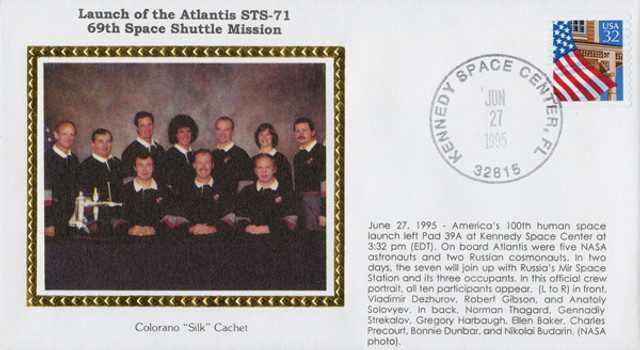On June 29, 1995, the US Space Shuttle Atlantis docked the Russian space station Mir for the first time.
The mission, STS-71, was the third in the US/Russian Shuttle-Mir program. It began on June 27, 1995, when Atlantis launched from Kennedy Space Center in Florida. This was the 100th US human space launch from Cape Canaveral.

Atlantis reached Mir two days later at 9 am on June 29, completing the first docking between a US space shuttle and Mir. It was also the first time US and Russian spacecraft linked up in orbit since the Apollo-Soyuz test project 20 years earlier.

When the two craft were linked, they had a total mass of about 225 metric tons. Once linked, the crews met in the Mir for a welcoming ceremony. The crews then spent about 100 hours over the next five days conducting a number of operations.
There were several objectives to the mission. One was to deliver a relief crew of two cosmonauts to Mir. Another was to conduct on-orbit joint US-Russian life sciences investigations. They were also to resupply Mir and recover a US astronaut to return home. Among the secondary objectives was filming with an IMAX camera and the Shuttle Amateur Radio Experiment-II (SAREX-II).
The mission included several more firsts. It was the first US Space-Shuttle-Russian Space Station docking and joint on-orbit operations, the largest spacecraft in orbit, and the first on-orbit change of shuttle crew.
On July 4 the crews held a farewell ceremony before undocking. The returning crew of eight people was the largest in shuttle history. They landed back on Earth on July 7.
Click here for lots more Space stamps and covers.
Click here for more about the mission from the NASA website.
| FREE printable This Day in History album pages Download a PDF of today’s article. Get a binder or other supplies to create your This Day in History album. |
Discover what else happened on This Day in History.





On NPR in the last couple weeks was an incredible story from a US astronaut about one of his experiences on Mir during a space walk. Told of how drastic the difference is between light and shadow in space. No air or dust to scatter light, so moving his arm into a shadow was as if that part of his arm was gone. Just no light. And how he and his fellow Cosmonaut faced the earth at the end of their tethers, with their backs to Mir. Just them passing over earth at 17,000 mph. And to top it off, they were unable to use the normal airlock to re-enter Mir. Spent several hours and nearly the last tiny bit of their oxygen scrubbers finding an alternate way back inside.
The US and Russia cooperation has been pretty decent, but definitely looking forward to us flying our own hardware again.